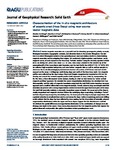Characterization of the in situ magnetic architecture of oceanic crust (Hess Deep) using near-source vector magnetic data
| dc.contributor.author | Tominaga, M | |
| dc.contributor.author | Tivey, MA | |
| dc.contributor.author | MacLeod, CJ | |
| dc.contributor.author | Morris, Antony | |
| dc.contributor.author | Lissenberg, CJ | |
| dc.contributor.author | Shillington, DJ | |
| dc.contributor.author | Ferrini, V | |
| dc.date.accessioned | 2017-08-07T10:07:08Z | |
| dc.date.available | 2017-08-07T10:07:08Z | |
| dc.date.issued | 2016-07-15 | |
| dc.identifier.issn | 2169-9313 | |
| dc.identifier.issn | 2169-9356 | |
| dc.identifier.uri | http://hdl.handle.net/10026.1/9678 | |
| dc.description.abstract |
<jats:title>Abstract</jats:title><jats:p>Marine magnetic anomalies are a powerful tool for detecting geomagnetic polarity reversals, lithological boundaries, topographic contrasts, and alteration fronts in the oceanic lithosphere. Our aim here is to detect lithological contacts in fast‐spreading lower crust and shallow mantle by characterizing magnetic anomalies and investigating their origins. We conducted a high‐resolution, near‐bottom, vector magnetic survey of crust exposed in the Hess Deep “tectonic window” using the remotely operated vehicle (ROV) <jats:italic>Isis</jats:italic> during RRS <jats:italic>James Cook</jats:italic> cruise JC21 in 2008. Hess Deep is located at the western tip of the propagating rift of the Cocos‐Nazca plate boundary near the East Pacific Rise (EPR) (2°15′N, 101°30′W). ROV <jats:italic>Isis</jats:italic> collected high‐resolution bathymetry and near‐bottom magnetic data as well as seafloor samples to determine the in situ lithostratigraphy and internal structure of a section of EPR lower crust and mantle exposed on the steep (~20°dipping) south facing slope just north of the Hess Deep nadir. Ten magnetic profiles were collected up the slope using a three‐axis fluxgate magnetometer mounted on ROV <jats:italic>Isis</jats:italic>. We develop and extend the vertical magnetic profile (VMP) approach of Tivey (1996) by incorporating, for the first time, a three‐dimensional vector analysis, leading to what we here termed as “vector vertical magnetic profiling” approach. We calculate the source magnetization distribution, the deviation from two dimensionality, and the strike of magnetic boundaries using both the total field Fourier‐transform inversion approach and a modified differential vector magnetic analysis. Overall, coherent, long‐wavelength total field anomalies are present with a strong magnetization contrast between the upper and lower parts of the slope. The total field anomalies indicate a coherently magnetized source at depth. The upper part of the slope is weakly magnetized and magnetic structure follows the underlying slope morphology, including a “bench” and lobe‐shaped steps, imaged by microbathymetry. The lower part of the slope is strongly magnetized, with a gradual reduction in amplitude from east to west across the slope. Surface morphology and recent drilling results indicate that the slope has been affected by mass wasting, but the observation of internally coherent magnetization distributions within the upper and lower slopes suggest that the disturbance is surficial. We attribute the spatial differences in magnetization distribution to the combination of changes in in situ lithology and depth to the source. These survey lines document the first magnetic profiles that capture the gabbro‐ultramafic and possibly dike‐gabbro boundaries in fast‐spreading lower crust.</jats:p> | |
| dc.format.extent | 4130-4146 | |
| dc.language | en | |
| dc.language.iso | en | |
| dc.publisher | American Geophysical Union (AGU) | |
| dc.title | Characterization of the in situ magnetic architecture of oceanic crust (Hess Deep) using near-source vector magnetic data | |
| dc.type | journal-article | |
| dc.type | Journal Article | |
| plymouth.author-url | http://gateway.webofknowledge.com/gateway/Gateway.cgi?GWVersion=2&SrcApp=PARTNER_APP&SrcAuth=LinksAMR&KeyUT=WOS:000381627300005&DestLinkType=FullRecord&DestApp=ALL_WOS&UsrCustomerID=11bb513d99f797142bcfeffcc58ea008 | |
| plymouth.issue | 6 | |
| plymouth.volume | 121 | |
| plymouth.publication-status | Published | |
| plymouth.journal | JOURNAL OF GEOPHYSICAL RESEARCH-SOLID EARTH | |
| dc.identifier.doi | 10.1002/2015JB012783 | |
| plymouth.organisational-group | /Plymouth | |
| plymouth.organisational-group | /Plymouth/Faculty of Science and Engineering | |
| plymouth.organisational-group | /Plymouth/Faculty of Science and Engineering/School of Geography, Earth and Environmental Sciences | |
| plymouth.organisational-group | /Plymouth/REF 2021 Researchers by UoA | |
| plymouth.organisational-group | /Plymouth/REF 2021 Researchers by UoA/UoA07 Earth Systems and Environmental Sciences | |
| plymouth.organisational-group | /Plymouth/Research Groups | |
| plymouth.organisational-group | /Plymouth/Research Groups/Marine Institute | |
| plymouth.organisational-group | /Plymouth/Users by role | |
| plymouth.organisational-group | /Plymouth/Users by role/Academics | |
| plymouth.organisational-group | /Plymouth/Users by role/Researchers in ResearchFish submission | |
| dcterms.dateAccepted | 2016-05-16 | |
| dc.identifier.eissn | 2169-9356 | |
| dc.rights.embargoperiod | No embargo | |
| rioxxterms.versionofrecord | 10.1002/2015JB012783 | |
| rioxxterms.licenseref.uri | http://www.rioxx.net/licenses/all-rights-reserved | |
| rioxxterms.licenseref.startdate | 2016-07-15 | |
| rioxxterms.type | Journal Article/Review | |
| plymouth.funder | Palaeomagnetic constraints on lower oceanic crustal processes (IODP Expedition 345 Hess Deep Plutonic Crust::NERC | |
| plymouth.oa-location | http://onlinelibrary.wiley.com/doi/10.1002/2015JB012783/full |


